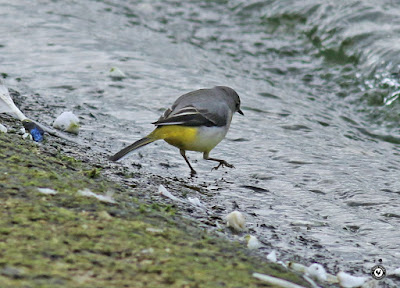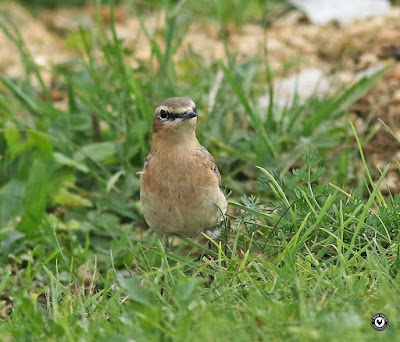By way of an alternative and by a small stroke of luck after a very early morning text message from a good friend, we were able to go to a local site near Oxford where an osprey had been present on and off for nearly a month. It was using a small lake in which to catch fish but our problem now was to find the location! I'd never been there before and it took a couple of phone calls to pin down the exact place. Luckily we found it and arrived just after 08:00 to find the osprey resting in a tree overlooking the small reed fringed lake.
The bird, which could be identified as an immature because of the pale feather edges, was clearly looking intently for its breakfast owing to its constant head movements. We were watching from around 75 metres away and the light wasn't great, the morning being overcast with periods of rain, but ospreys are large birds so our views were excellent. The osprey remained in the tree for just over half an hour when suddenly and with little warning it dropped out of the tree and dived towards the water.
Surprisingly it didn't enter the water directly below or even close to the lookout but at a point parallel to our position. The actual moment of impact was hidden by a small island but the bird had selected a fish some 75-100 metres away from where it had been watching from offering great testament to amazing eyesight on its part. When the osprey emerged back into view a roach was firmly gripped in its talons and it carried it away through the surrounding trees and away to another unseen perch in which to consume it. From leaving the tree and departing with the fish had taken all of 20 seconds! Blink and you'd miss it but thankfully, as the photos prove, I didn't!
After the thrill of the osprey we had the added enjoyment of watching a kingfisher hunt its own meal. Although it never came in too close, it was easy to observe as it, in turns, hovered above the water and perched on reed stems. It wasn't anywhere near as successful as the osprey though and in repeated dives it never caught anything. There were other birds too, moorhens and coots, a small band of warblers and tits moving through the bushes and a buzzard mewing from a distant tree. Green woodpeckers were noisily feeding on the short grass away from the lake and a water rail squealed from inside the reedbed.
Since we close to Oxford we decided to have a look around Farmoor and grab a coffee from the cafe there. The weather had settled down a bit now and was seemingly set fair and with little wind the reservoir surface was mostly unruffled. In my experience Farmoor is quieter with regards to birds when the wind is light but there is usually always something to find. On this occasion though there was very little!
The water level on both reservoirs had been dropped by about 2 metres since our last visit exposing a large swathe of bare concrete meaning that the weed and algae growing by the edge of the water was now left high and dry and thus offering little sustenance to any visiting waders and their like. We did spot a lone dunlin close to the marina on F2 but a compete scan of both basins revealed no more wading birds.
The best bird was a male sparrowhawk which came gliding past as we strolled past the boat club but it was past us by the time I swung the camera into action!
A yellow wagtail was feeding along the causeway with at least 30 pied wagtails and a grey wagtail fed alone on F2.
Two wheatears were seen along the grassy bank next to the treatment works with more pied wagtails (a major influx) and a few linnets. There were still some swallows hawking over the grassy areas and lots of sand martins were active over F2. But, like I said, Farmoor was quiet!
And the sabines gull was not seen at Daventry so likely had succumbed during the night.




















No comments:
Post a Comment